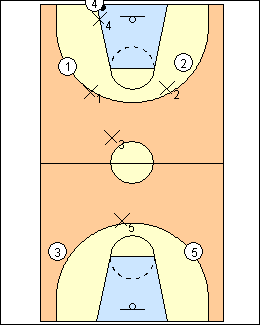 | 1 The 1-2-1-1 fullcourt zone press can - trap if the inbounds pass is made - defend on a pass back to the inbounder - trap on a reverse to the other side - trap again on a pass up the sideline - trap again on a pass to the defensive corner Defenders must sprint back when the press is beaten, usually when the ball gets to the middle behind the front-line defenders. Trapping progressions are - any backcourt lateral pass - any backcourt lateral or sideline pass - any backcourt pass - any pass not a direct threat to the basket. As shown below, options include: - deny or direct the inbounds pass - trap on the inbounds pass (quick trap) or on the dribble (slow trap) - pressure the inbounder or face guard the point guard - allow or contest ball reversal - match up into fullcourt man to man. |
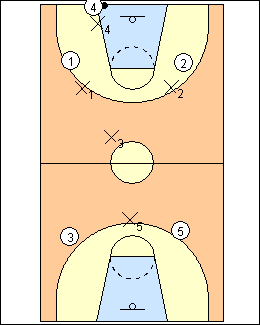 | 2 The point pressures/directs the inbounds pass, forces the dribble sideline, traps with wing defenders in the frontcourt, and protects the middle. Must be a good trapper, is often the athletic big, but can be a centre to have a quicker defender at the back. Wings trap with the point, centre, and safety. The weakside wing covers the middle, is the safety as needed. Wings are often forwards, the left (tight) wing a good trapper and/or better athlete than the right (wide) wing. The centre (monster) prevents a pass over the front line, sideline traps in the midcourt area with a wing. Is often the quickest guard, as shallow middle is a weakness of the press. The safety covers the sidelines in the backcourt, traps with a wing in the corner. Can be a big or second-quickest guard. Moves up opposite the ball if there is no attacker in the defensive backcourt. |
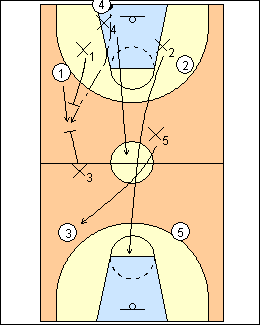 | 3 Deny option Defenders must match up with attackers. If the attacking team brings five players back, the safety moves into the frontcourt and guards the player on the side opposite the ball. If the inbounds pass can't be denied, it should be influenced to either corner (usually the left) - prevent a pass to the middle. Once the ball is inbounded, the safety looks to retreat to the backcourt. Full inbounds denial disguises the zone press, works best if your team is athletic, and may be needed to catch up quickly late in a game. Option - the wing defenders face guard, encouraging a lob pass over the top for an interception or trap (50-off option of the Australia 1-2-1-1). |
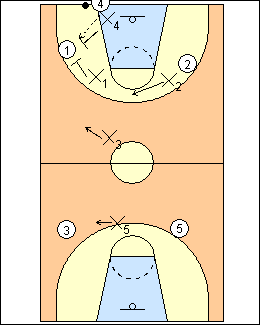 | 4 If the inbounds pass is not denied, it should be made in front of a wing, who stands back far enough to prevent a pass behind him. Once the ball is passed into the corner, the wing approaches the ballhandler quickly but under control, protecting the sideline against the dribble. He pressures and contains the ballhandler until another defender arrives. Defenders have time on their side. X3 reads the inbounds passer, e.g., anticipating a long pass if he turns sideways or a short pass if parallel to the baseline with the ball in both hands. Ken Lindsay - if the inbounder hesitates for a few seconds on the pass, the wings attack the attackers in front of them to force a 5-second count or a long hurried pass. John Kimble - X2 and X3 split the difference in spacing between the ballside midcourt, near the top of the circle, and below the basket, but the middle is most vulnerable. |
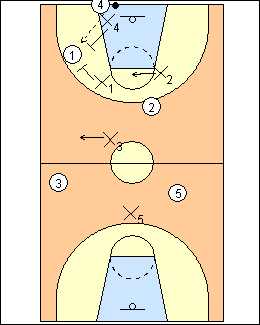 | 5 Quick trap - Point X4 directs the inbounds pass to the defensive left, and immediately (but under control) traps with wing X1. Weakside wing X2 protects the middle at or below ball level, reading the passer to anticipate a pass. Centre X3 stays on the vertical line of the ball. Vivian Stringer - X3 becomes the thief, always behind the trap. Slow trap - The point defender could instead deny the pass back to the inbounder, then trap with the wing defender only after the ballhandler puts the ball on the floor to start his dribble, when a double team is more effective. An option is for the point defender to drop back to ball level then slow trap John Kimble - does not quick trap an inbounds pass to the wide side. |
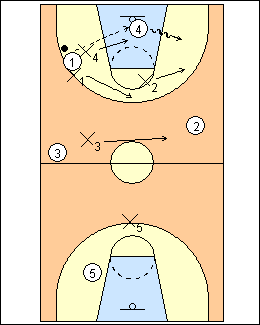 | 6 The pass back to the inbounder is usually not contested, especially if he is not a threat to dribble the ball. Use the same trapping technique. The point forces the ballhandler towards the other sideline and into a trap with wing X2. Wing defenders always prevent the ballhandler from dribbling up the sideline. If more than two defenders trap the ball, too many attackers are left open. Variations - instead of covering the middle after the pass back to the inbounder, X1 denies primary ballhandler O1(Australia 1-2-1-1) - X4 and X2 trap the inbounder in the centre of the court, but the passing angles are excellent (Basketball Canada). |
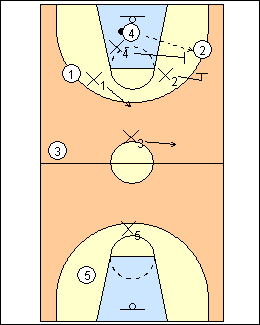 | 7 If inbounder O4 reverses the ball to O2, X4 and X2 set a trap, X1 protects the middle, and X3 vertically parallels the ball. Basketball Canada - X5 moves up to be the ballside interceptor, X1 rotates back as safety, X3 is the middle interceptor. John Kimble - X5 traps with X2 on the sideline as the ball is dribbled across halfcourt, X3 covers up the sideline, X1 covers the middle, and X4 is the safety protecting the basket. |
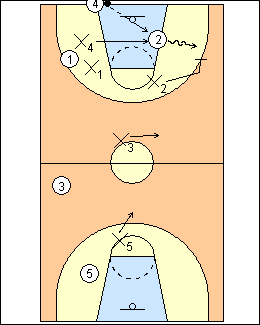 | 8 Face guard option To defend a team that has one strong guard, the point defender and a wing can double-team deny an inbounds pass to that player. X4 face guards O1 instead of pressuring the inbounder. Once the inbounds pass is made to a different attacker, the point moves to trap with the other wing, while X1 denies a pass back to the strong guard. |
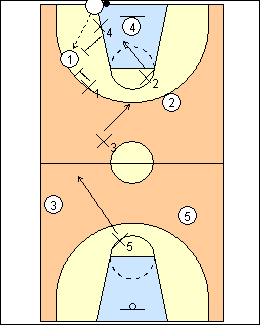 | 9 John Kimble stunts Pinch - On the first trap centre X3 denies the middle while X2 shoots the gap looking to intercept a pass back to the inbounder. The ballside sideline is left open. Swarm (shown) - Pinch, plus safety X5 shoots the gap looking to intercept a pass up the ballside sideline, leaving open a receiver furthest from the trap. Match-up - On the first trap centre X4 and weakside X2 cover passes up the ballside sideline and to the middle, as usual. On ball reversal, point X4 follows the pass and takes the ball. All defenders match up with closest attackers and play fullcourt man defence, then go into the normal halfcourt defence when the ball nears the hash marks in the backcourt. Safe, effective if the inbounder is mismatched against X4. (George Mason fullcourt scramble match-up option - X1 denies O1.) |
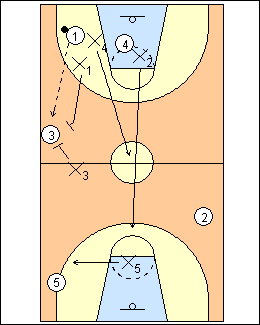 | 10 The 1-2-1-1 zone will trap on a dribble or a perimeter pass (a back, lateral, or sideline pass). Here a second sideline trap is made, by the left wing and centre (centre X3 prevents the sideline dribble). X4 moves to be the middle interceptor, X5 rotates as sideline interceptor, and weakside wing X2 rotates to be the safety. Variations - X1 denies O1 instead of trapping with X3 (Australia 1-2-1-1) - X4 gaps against a back pass to O1 or O4, X2 covers O2 - X2 and X4 trap if O3 skip passes to O2, as in the 2-2-1 press (also see the Australia 1-2-1-1). A coaching option is a "one and done" trap - sprint back into the halfcourt defence if the attackers pass out of the trap, or defenders are unable to set the trap. |
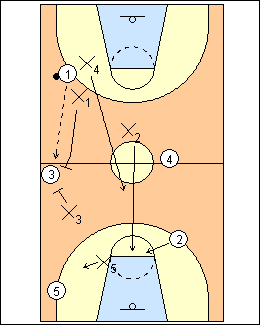 | 11 Here the wing and centre defenders trap in their backcourt. X4 moves into the backcourt as a middle interceptor, since the attackers cannot pass back over centre. Ken Lindsay - the safety plays to the ballside side of the foul lane as the ball crosses midcourt and anticipates a corner double team. Ken Lindsay - if the ball gets past the centre up the sideline, he sprints to the ballside post area. Alan Lambert - the centre rotates back to the safety position if the safety tries to deny or pressure a long pass up the ballside sideline |
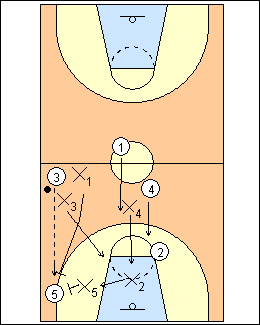 | 12 Safety X5 and wing X1 trap on another pass up the sideline. X2 moves over to cover a pass into the middle, X4 covers the lane, and X3 covers the ballside elbow or a pass out of the trap back towards midcourt. Ken Lindsay - centre X3 sprints down to the post area, point defender X4 is at the ballside elbow, and weakside wing X2 is under the basket. The defence can fall back into a man to man or zone defence. |
This page was made with Basketball playbook from Jes-Soft